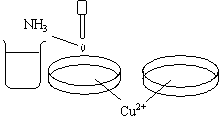Combined or Mixed Equilibria of Cu²⁺
- Page ID
- 2981
\( \newcommand{\vecs}[1]{\overset { \scriptstyle \rightharpoonup} {\mathbf{#1}} } \)
\( \newcommand{\vecd}[1]{\overset{-\!-\!\rightharpoonup}{\vphantom{a}\smash {#1}}} \)
\( \newcommand{\id}{\mathrm{id}}\) \( \newcommand{\Span}{\mathrm{span}}\)
( \newcommand{\kernel}{\mathrm{null}\,}\) \( \newcommand{\range}{\mathrm{range}\,}\)
\( \newcommand{\RealPart}{\mathrm{Re}}\) \( \newcommand{\ImaginaryPart}{\mathrm{Im}}\)
\( \newcommand{\Argument}{\mathrm{Arg}}\) \( \newcommand{\norm}[1]{\| #1 \|}\)
\( \newcommand{\inner}[2]{\langle #1, #2 \rangle}\)
\( \newcommand{\Span}{\mathrm{span}}\)
\( \newcommand{\id}{\mathrm{id}}\)
\( \newcommand{\Span}{\mathrm{span}}\)
\( \newcommand{\kernel}{\mathrm{null}\,}\)
\( \newcommand{\range}{\mathrm{range}\,}\)
\( \newcommand{\RealPart}{\mathrm{Re}}\)
\( \newcommand{\ImaginaryPart}{\mathrm{Im}}\)
\( \newcommand{\Argument}{\mathrm{Arg}}\)
\( \newcommand{\norm}[1]{\| #1 \|}\)
\( \newcommand{\inner}[2]{\langle #1, #2 \rangle}\)
\( \newcommand{\Span}{\mathrm{span}}\) \( \newcommand{\AA}{\unicode[.8,0]{x212B}}\)
\( \newcommand{\vectorA}[1]{\vec{#1}} % arrow\)
\( \newcommand{\vectorAt}[1]{\vec{\text{#1}}} % arrow\)
\( \newcommand{\vectorB}[1]{\overset { \scriptstyle \rightharpoonup} {\mathbf{#1}} } \)
\( \newcommand{\vectorC}[1]{\textbf{#1}} \)
\( \newcommand{\vectorD}[1]{\overrightarrow{#1}} \)
\( \newcommand{\vectorDt}[1]{\overrightarrow{\text{#1}}} \)
\( \newcommand{\vectE}[1]{\overset{-\!-\!\rightharpoonup}{\vphantom{a}\smash{\mathbf {#1}}}} \)
\( \newcommand{\vecs}[1]{\overset { \scriptstyle \rightharpoonup} {\mathbf{#1}} } \)
\( \newcommand{\vecd}[1]{\overset{-\!-\!\rightharpoonup}{\vphantom{a}\smash {#1}}} \)
Chemical Concept Demonstrated
- Complex-formation equilibrium
Demonstration
Each of the dishes contain Cu 2+ ion solution.
|
 |
Observations
A precipitate forms as the ammonia is added dropwise into the dish. Additional ammonia causes the precipitate to dissolve and a dark-blue solution is formed.
Explanations (including important chemical equations)
A light-blue colored precipitate of Cu(OH)2 is formed when aqueous ammonia is added to Cu 2+ ion solution.
Cu 2+ (aq) + 2 (OH)- (aq) <=> Cu(OH)2 (s) Ksp = 2.2 x 10-20
In the presence of excess NH3, this equilibrium shifts to the left as the free Cu 2+ ion is sequestered from the solution as the Cu(NH3)4 2+ complex ion.
Cu 2+ (aq) + 4 NH3 (aq) <=> Cu(NH3)4 2+ (aq) Ksp = 2.1 x 1013
The intensity of the absorption of light by the Cu(NH3)4 2+ complex appears to be orders of magnitude greater than the corresponding Cu(H2O)6 2+ complex. The molar absorbances of these complexes, however, differ, roughly, only by a factor of four. The difference between the intensities of the colors of these complexes can be explained by noting that the maximum wavelength for the Cu(H2O)6 2+ complex is about 800 nm, whereas the maximum wavelength for the Cu(NH3)42+ complex occurs at about 600 nm. Since a larger portion of the absorption in the Cu(NH3)4 2+ complex is in the visible portion of the spectrum, the color appears considerably more intense.
Contributors
- Dr. George Bodner (Perdue University)

